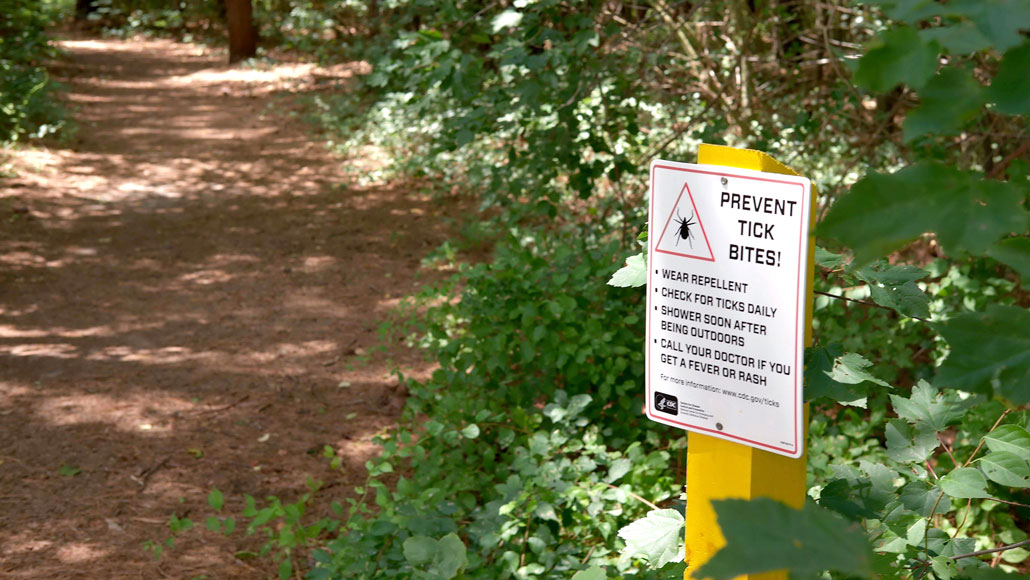The animals that ticks bite in the U.S. South can impact Lyme disease spread
In the South, ticks attach more often to skinks, which don’t pass on Lyme bacteria as well as mice

Black-legged ticks (Ixodes scapularis) are found throughout the eastern half of the United States in woodland areas such as this in one in Delaware. Yet cases of Lyme disease are much more common in the North than the South.
Herb Quick/Alamy Stock Photo
- More than 2 years ago
The paucity of Lyme disease cases in the southern United States may be partly due to what black-legged ticks in southern locales bite.
Although black-legged ticks (Ixodes scapularis) claim much of the eastern half of the country as their home, the Lyme disease they spread is largely concentrated in the Northeast and increasingly in the upper Midwest.
It’s well known that ticks in the Northeast commonly latch on to white-footed mice. This relationship turns out to be a boon for Lyme disease. When infected with the bacteria Borrelia burgdorferi, which causes Lyme disease, these mice very efficiently spread it to the ticks, which can then pass it on to people.
But southern-residing ticks are different. They are more likely to bite lizards called skinks, which are poor transmitters of the bacteria, researchers report January 28 in PLOS Biology.
This study “shows that there’s this really interesting switch” north to south in the predominant tick host, says disease ecologist Shannon LaDeau of the Cary Institute of Ecosystem Studies in Millbrook, N.Y., who was not part of the research team. “It looks like that is reducing the transmission” in the South of the bacteria that causes Lyme disease.
An estimated 476,000 people are diagnosed with Lyme disease each year in the United States, according to insurance data from 2010 to 2018. In about 70 to 80 percent of cases, a rash in the area of the tick bite is an early sign of the disease; other symptoms include fever, fatigue and achiness. Most people recover with early antibiotic treatment. If the diagnosis is missed, the infection can spread in the body and cause arthritis and nerve pain (SN: 6/22/19).
Scanning for and removing ticks after a hike is one part of Lyme disease control. Understanding the ticks’ behavior and their relationship to the environment can inform other prevention methods.
Black-legged ticks need blood meals to progress through several developmental stages. The larvae that emerge from eggs are the first to seek out a host for blood; this is the point when they can first become infected with Lyme bacteria. The next blood meal is at the nymph stage. Nymphs infected as larvae can spread the bacteria to other hosts, including people.
There’s been a long debate about the difference in Lyme disease cases between the North and the South, says research ecologist Howard Ginsberg at the Patuxent Coastal Field Station at the University of Rhode Island in Kingston. The ticks are in the South, so “why isn’t there much Lyme disease?”
One possible reason is that nymphal ticks in the North seek hosts on top of or above leaf litter, which puts them in the path of passing hikers. But nymphal ticks in the South are more likely to stay under leaf litter, reducing the chance of such encounters, researchers reported in Ticks and Tick-borne Diseases in 2019. It may be that the ticks remain below the leaf litter in the hotter South to avoid drying out.
This host-seeking behavior and the results of the new study help to explain the North-South difference, Ginsberg says. In 2011 and 2012, he and his colleagues captured host animals in live traps and collected and tested ticks at eight sites in the eastern half of the United States. “We tried to catch everything that crawled on the ground that the tick might attach to,” he says.
In the North, the most common hosts were mice, while in the South, the ticks selectively attached to skinks, Ginsberg says. At the Massachusetts site, for example, 75 percent of the larvae and 93 percent of the nymphs were removed from mice, which accounted for 79 percent of the captured host animals. The team caught no skinks.
But at the Florida site, although around 40 percent of the animals captured were mice, they had only 3 percent of the larvae and less than 1 percent of the nymphs. Meanwhile, skinks — which made up 28 percent of the host animals captured — had 92 percent of the larvae and 98 percent of the nymphs. The team also found that the ticks at the northern sites were much more likely to be infected with Lyme bacteria than ticks from southern sites.
Understanding the ecological context of Lyme disease can help identify targets to try to reduce human risk, LaDeau says. For example, the possibility of vaccinating mice against Lyme bacteria (SN: 8/9/17) may be more useful in the North.
The differences seen north to south also influence predictions of how climate change could impact Lyme disease. Black-legged ticks have moved farther north, bringing Lyme disease to Canada, in part due to warming. Perhaps the behaviors and biting patterns in the South will eventually expand to Maryland, Delaware and Virginia, reducing Lyme disease cases there, says Ginsberg. It will take more research to learn how climate change will affect skink populations and how warming might change tick behavior, he says.







